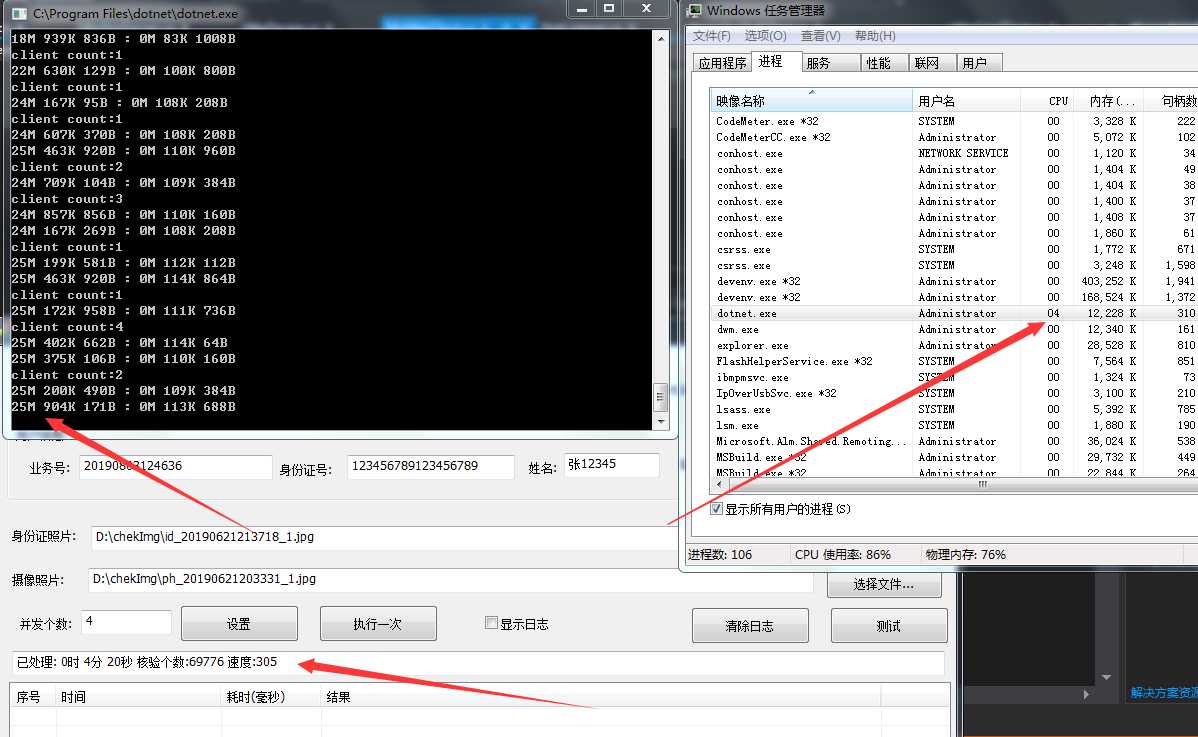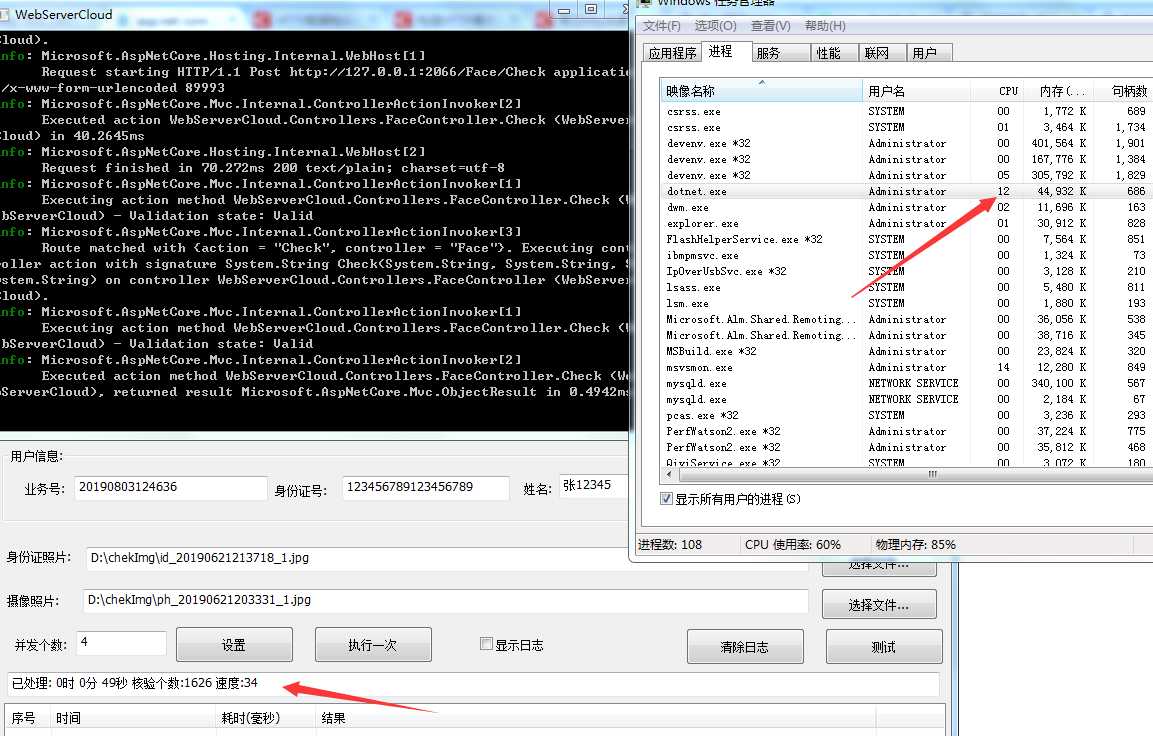标签:代码 ons socket incr for param 通讯协议 服务器开发 text
前言 http协议是互联网上使用最广泛的通讯协议了。web通讯也是基于http协议;对应c#开发者来说,asp.net core是最新的开发web应用平台。由于最近要开发一套人脸识别系统,对通讯效率的要求很高。虽然.net core对http处理很优化了,但是我决定开发一个轻量级http服务器;不求功能多强大,只求能满足需求,性能优越。本文以c#开发windows下http服务器为例。
经过多年的完善、优化,我积累了一个非常高效的网络库(参见我的文章:高性能通讯库)。以此库为基础,开发一套轻量级的http服务器难度并不大。我花了两天的时间完成http服务器开发,并做了测试。同时与asp.net core处理效率做了对比,结果出乎意料。我的服务器性能是asp.net core的10倍。对于此结果,一开始我也是不相信,经过多次反复测试,事实却是如此。此结果并不能说明我写的服务器优于asp.net core,只是说明一个道理:合适的就是最好,高大上的东西并不是最好的。
1 HTTP协议特点

HTTP协议是基于TCP/IP之上的文本交换协议。对于开发者而言,也属于socket通讯处理范畴。只是http协议是请求应答模式,一次请求处理完成,则立即断开。http这种特点对sokcet通讯提出几个要求:
a) 能迅速接受TCP连接请求。TCP是面向连接的,在建立连接时,需要三次握手。这就要求socket处理accept事件要迅速,要能短时间处理大量连接请求。
b) 服务端必须采用异步通讯模式。对windows而言,底层通讯就要采取IOCP,这样才能应付成千上万的socket请求。
c) 快速的处理读取数据。tcp是流传输协议,而http传输的是文本协议;客户端向服务端发送的数据,服务端可能需要读取多次,服务端需要快速判断数据是否读取完毕。
以上几点只是处理http必须要考虑的问题,如果需要进一步优化,必须根据自身的业务特点来处理。
2 快速接受客户端的连接请求
采用异步Accept接受客户端请求。这样的好处是:可以同时投递多个连接请求。当有大量客户端请求时,能快速建立连接。
异步连接请求代码如下:
public bool StartAccept() { SocketAsyncEventArgs acceptEventArgs = new SocketAsyncEventArgs(); acceptEventArgs.Completed += AcceptEventArg_Completed; bool willRaiseEvent = listenSocket.AcceptAsync(acceptEventArgs); Interlocked.Increment(ref _acceptAsyncCount); if (!willRaiseEvent) { Interlocked.Decrement(ref _acceptAsyncCount); _acceptEvent.Set(); acceptEventArgs.Completed -= AcceptEventArg_Completed; ProcessAccept(acceptEventArgs); } return true; }
可以设置同时投递的个数,比如此值为10。当异步连接投递个数小于10时,立马再次增加投递。有一个线程专门负责投递。
_acceptAsyncCount记录当前正在投递的个数,MaxAcceptInPool表示同时投递的个数;一旦_acceptAsyncCount小于MaxAcceptInPool,立即增加一次投递。
private void DealNewAccept() { try { if (_acceptAsyncCount <= MaxAcceptInPool) { StartAccept(); } } catch (Exception ex) { _log.LogException(0, "DealNewAccept 异常", ex); } }
3 快速分析从客户端收到的数据
比如客户端发送1M数据到服务端,服务端收到1M数据,需要读取的次数是不确定的。怎么样才能知道数据是否读取完?
这个细节处理不好,会严重影响服务器的性能。毕竟服务器要对大量这样的数据进行分析。
http包头举例
POST / HTTP/1.1 Accept: */* Content-Type: application/x-www-from-urlencoded Host: www.163.com Content-Length: 7 Connection: Keep-Alive
body
分析读取数据,常规、直观的处理方式如下:
1) 将收到的多个buffer合并成一个buffer。如果读取10次才完成,则需要合并9次。
2) 将buffer数据转成文本。
3) 找到文本中的http包头结束标识("\r\n\r\n") 。
4) 找到Content-Length,根据此值判断是否接收完成。
采用上述处理方法,将严重影响处理性能。必须另辟蹊径,采用更优化的处理方法。
优化后的处理思路
1)多缓冲处理
基本思路是:收到所有的buffer之前,不进行buffer合并。将缓冲存放在List<byte[]> listBuffer中。通过遍历listBuffer来查找http包头结束标识,来判断是否接收完成。
类BufferManage负责管理buffer。
public class BufferManage { List<byte[]> _listBuffer = new List<byte[]>(); public void AddBuffer(byte[] buffer) { _listBuffer.Add(buffer); } public bool FindBuffer(byte[] destBuffer, out int index) { index = -1; int flagIndex = 0; int count = 0; foreach (byte[] buffer in _listBuffer) { foreach (byte ch in buffer) { count++; if (ch == destBuffer[flagIndex]) { flagIndex++; } else { flagIndex = 0; } if (flagIndex >= destBuffer.Length) { index = count; return true; } } } return false; } public int TotalByteLength { get { int count = 0; foreach (byte[] item in _listBuffer) { count += item.Length; } return count; } } public byte[] GetAllByte() { if (_listBuffer.Count == 0) return new byte[0]; if (_listBuffer.Count == 1) return _listBuffer[0]; int byteLen = 0; _listBuffer.ForEach(o => byteLen += o.Length); byte[] result = new byte[byteLen]; int index = 0; foreach (byte[] item in _listBuffer) { Buffer.BlockCopy(item, 0, result, index, item.Length); index += item.Length; } return result; } public byte[] GetSubBuffer(int start, int countTotal) { if (countTotal == 0) return new byte[0]; byte[] result = new byte[countTotal]; int countCopyed = 0; int indexOfBufferPool = 0; foreach (byte[] buffer in _listBuffer) { //找到起始复制点 int indexOfItem = 0; if (indexOfBufferPool < start) { int left = start - indexOfBufferPool; if (buffer.Length <= left) { indexOfBufferPool += buffer.Length; continue; } else { indexOfItem = left; indexOfBufferPool = start; } } //复制数据 int dataLeft = buffer.Length - indexOfItem; int dataNeed = countTotal - countCopyed; if (dataNeed >= dataLeft) { Buffer.BlockCopy(buffer, indexOfItem, result, countCopyed, dataLeft); countCopyed += dataLeft; } else { Buffer.BlockCopy(buffer, indexOfItem, result, countCopyed, dataNeed); countCopyed += dataNeed; } if (countCopyed >= countTotal) { Debug.Assert(countCopyed == countTotal); return result; } } throw new Exception("没有足够的数据!"); // return result; } }
类HttpReadParse借助BufferManage类,实现对http文本的解析。
1 public class HttpReadParse 2 { 3 4 BufferManage _bufferManage = new BufferManage(); 5 6 public void AddBuffer(byte[] buffer) 7 { 8 _bufferManage.AddBuffer(buffer); 9 } 10 11 public int HeaderByteCount { get; private set; } = -1; 12 13 string _httpHeaderText = string.Empty; 14 public string HttpHeaderText 15 { 16 get 17 { 18 if (_httpHeaderText != string.Empty) 19 return _httpHeaderText; 20 21 if (!IsHttpHeadOver) 22 return _httpHeaderText; 23 24 byte[] buffer = _bufferManage.GetSubBuffer(0, HeaderByteCount); 25 _httpHeaderText = Encoding.UTF8.GetString(buffer); 26 return _httpHeaderText; 27 } 28 } 29 30 string _httpHeaderFirstLine = string.Empty; 31 public string HttpHeaderFirstLine 32 { 33 get 34 { 35 if (_httpHeaderFirstLine != string.Empty) 36 return _httpHeaderFirstLine; 37 38 if (HttpHeaderText == string.Empty) 39 return string.Empty; 40 int index = HttpHeaderText.IndexOf(HttpConst.Flag_Return); 41 if (index < 0) 42 return string.Empty; 43 44 _httpHeaderFirstLine = HttpHeaderText.Substring(0, index); 45 return _httpHeaderFirstLine; 46 } 47 } 48 49 public string HttpRequestUrl 50 { 51 get 52 { 53 if (HttpHeaderFirstLine == string.Empty) 54 return string.Empty; 55 56 string[] items = HttpHeaderFirstLine.Split(‘ ‘); 57 if (items.Length < 2) 58 return string.Empty; 59 60 return items[1]; 61 } 62 } 63 64 public bool IsHttpHeadOver 65 { 66 get 67 { 68 if (HeaderByteCount > 0) 69 return true; 70 71 byte[] headOverFlag = HttpConst.Flag_DoubleReturnByte; 72 73 if (_bufferManage.FindBuffer(headOverFlag, out int count)) 74 { 75 HeaderByteCount = count; 76 return true; 77 } 78 return false; 79 } 80 } 81 82 int _httpContentLen = -1; 83 public int HttpContentLen 84 { 85 get 86 { 87 if (_httpContentLen >= 0) 88 return _httpContentLen; 89 90 if (HttpHeaderText == string.Empty) 91 return -1; 92 93 int start = HttpHeaderText.IndexOf(HttpConst.Flag_HttpContentLenth); 94 if (start < 0) //http请求没有包体 95 return 0; 96 97 start += HttpConst.Flag_HttpContentLenth.Length; 98 99 int end = HttpHeaderText.IndexOf(HttpConst.Flag_Return, start); 100 if (end < 0) 101 return -1; 102 103 string intValue = HttpHeaderText.Substring(start, end - start).Trim(); 104 if (int.TryParse(intValue, out _httpContentLen)) 105 return _httpContentLen; 106 return -1; 107 } 108 } 109 110 public string HttpAllText 111 { 112 get 113 { 114 byte[] textBytes = _bufferManage.GetAllByte(); 115 string text = Encoding.UTF8.GetString(textBytes); 116 return text; 117 } 118 } 119 120 public int TotalByteLength => _bufferManage.TotalByteLength; 121 122 public bool IsReadEnd 123 { 124 get 125 { 126 if (!IsHttpHeadOver) 127 return false; 128 129 if (HttpContentLen == -1) 130 return false; 131 132 int shouldLenth = HeaderByteCount + HttpContentLen; 133 bool result = TotalByteLength >= shouldLenth; 134 return result; 135 } 136 } 137 138 public List<HttpByteValueKey> GetBodyParamBuffer() 139 { 140 List<HttpByteValueKey> result = new List<HttpByteValueKey>(); 141 142 if (HttpContentLen < 0) 143 return result; 144 Debug.Assert(IsReadEnd); 145 146 if (HttpContentLen == 0) 147 return result; 148 149 byte[] bodyBytes = _bufferManage.GetSubBuffer(HeaderByteCount, HttpContentLen); 150 151 //获取key value对应的byte 152 int start = 0; 153 int current = 0; 154 HttpByteValueKey item = null; 155 foreach (byte b in bodyBytes) 156 { 157 if (item == null) 158 item = new HttpByteValueKey(); 159 160 current++; 161 if (b == ‘=‘) 162 { 163 byte[] buffer = new byte[current - start - 1]; 164 Buffer.BlockCopy(bodyBytes, start, buffer, 0, buffer.Length); 165 item.Key = buffer; 166 start = current; 167 } 168 else if (b == ‘&‘) 169 { 170 byte[] buffer = new byte[current - start - 1]; 171 Buffer.BlockCopy(bodyBytes, start, buffer, 0, buffer.Length); 172 item.Value = buffer; 173 start = current; 174 result.Add(item); 175 item = null; 176 } 177 } 178 179 if (item != null && item.Key != null) 180 { 181 byte[] buffer = new byte[bodyBytes.Length - start]; 182 Buffer.BlockCopy(bodyBytes, start, buffer, 0, buffer.Length); 183 item.Value = buffer; 184 result.Add(item); 185 } 186 187 return result; 188 } 189 190 public string HttpBodyText 191 { 192 get 193 { 194 if (HttpContentLen < 0) 195 return string.Empty; 196 Debug.Assert(IsReadEnd); 197 198 if (HttpContentLen == 0) 199 return string.Empty; 200 201 byte[] bodyBytes = _bufferManage.GetSubBuffer(HeaderByteCount, HttpContentLen); 202 string bodyString = Encoding.UTF8.GetString(bodyBytes); 203 return bodyString; 204 } 205 } 206 207 }
4 性能测试
采用模拟客户端持续发送http请求测试,每个http请求包含两个图片。一次http请求大概发送70K数据。服务端解析数据后,立即发送应答。
注:所有测试都在本机,客户端无法模拟大量http请求,只能做简单压力测试。
1)本人所写的服务器,测试结果如下
每秒可发送300次请求,每秒发送数据25M,服务器cpu占有率为4%。

2)asp.net core 服务器性能测试

每秒发送30次请求,服务器cpu占有率为12%。
测试对比:本人开发的服务端处理速度为asp.net core的10倍,cpu占用为对方的三分之一。asp.net core处理慢,有可能实现了更多的功能;只是这些隐藏的功能,对我们也没用。
后记: 如果没有开发经验,没有清晰的处理思路,开发一个高效的http服务器还有很困难的。本人也一直以来都是采用asp.net core作为http服务器。因为工作中需要高效的http服务器,就尝试写一个。不可否认,asp.net core各方面肯定优化的很好;但是,asp.net core 提供的某些功能是多余的。如果化繁为简,根据业务特点开发,性能未必不能更优。
标签:代码 ons socket incr for param 通讯协议 服务器开发 text
原文地址:https://www.cnblogs.com/yuanchenhui/p/httpserver.html